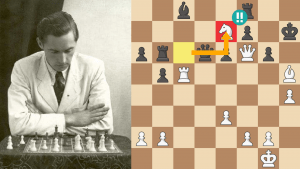
Dreams: The Secret Formula For Chess Success, Part 2
What in the world is a chess dream? And how can such a thing help your game?
For those that want the full introductory prose, please go to part one of this series. For the busy masses who have things to do and places to go, here’s a nutshell explanation:
This series is all about dreams (okay, it’s also about imbalances and patterns), and it’s presented in a question-and-answer format. Some of the positions will be hard to deconstruct, some will be very basic, but all of them should prove instructive once you do your best to solve the puzzles and then carefully read the prose in the answers.
Chess dreams: No, we’re not talking about a chess dream where you beat Hou Yifan 6-0 in a match, and then do the same to Magnus.

The chess dream I’m talking about is:
A) You break down the nuts and bolts of the position (imbalances, dynamics, tactics, pawn structures, etc.) as best you can (more concepts than moves!).
B) Then you imagine (Dream!) the ideal position based on your earlier breakdown. No move-by-move, “I go there and he goes there” analysis!
C) That’s enough, but if you wish to go a bit deeper down that rabbit hole, then look for a sequence of moves that actually makes (or at least aims at making) your dream come true.

PUZZLES
Puzzle One:
Both sides have their own dreams, based on the pawn structure. These dreams may or may not happen, but it’s important that you see them. What do you think Black’s strategic fantasy is (which, by the way, can only happen if White helps him out), and what do you think White’s (very real) strategic dreams are?
Puzzle Two:
White has two strategic goals. One is obvious (which doesn’t make it any less important!), but the other is in the dream realm since it doesn’t seem pertinent at this time. See if you can find the obvious and, after that, the hard-to-find dream.
ANSWERS
Puzzle One Answer, Black’s Dream:
Black owns the dark-squares, thanks to his mighty g7-bishop. He also owns the e5-square, which will be a magnificent home for Black’s knight or bishop.
Puzzle One Answer, White’s Dreams:
White has managed to exchange his bad light-squared bishop for Black’s good bishop. As a result, White owns the hole on f5 and Black’s remaining bishop is blocked by its own pawns.
Black has managed to play the thematic ...f7-f5, but the exchange of pawns on that square has given White control of e4, which is an excellent home for a White knight. Moreover, by occupying that square the e5-pawn is frozen and the g7-bishop is hitting granite.
Here is a possible series of moves from our original position:
Puzzle Two Answer:
White is a bit better since his position is more flexible: Black’s knights don’t have any permanent posts, his dark-squared bishop is playing defense, and a clear plan (other than attacking the d3-pawn) is hard to find. White’s obvious plan is to tie Black down to the defense of e5, which White is clearly doing.
The dream, though, is all about the fianchettoed bishops. If White can crack those diagonals then his bishops will be clearly superior to Black’s. Only by noticing the White bishop’s potential along the long diagonals will you be able to play the position properly. In other words, first comes the dream, then comes the moves.
Here’s the actual game continuation:
RELATED STUDY MATERIAL
- Read IM Silman's previous article: Dreams: The Secret Formula For Chess Success.
- Watch GM Eugene Perelshteyn's video: Hammertime With Magnus!
- Take a lesson on planning in the Chess Mentor.
- Solve some puzzles in the Tactics Trainer.
- Looking for articles with deeper analysis? Try our magazine: The Master's Bulletin.






